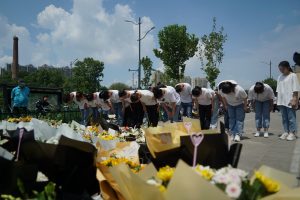Residents laid bouquet after bouquet, the neatly tied yellow and white flowers standing on end, on Tuesday outside an entrance to a subway station in central China where 14 people died last week after a record-breaking downpour flooded large swaths of Henan province.
Torrents of water rushed into a subway line in the provincial capital, Zhengzhou, trapping a train with hundreds of passengers between two stations. The deluge drowned some and left others gasping for breath in chest-high water until emergency crews could reach them.
“I’m filled with grief,” said Zhengzhou resident Zhang Shuai, 35, who bowed three times in front of the entrance after laying a bouquet of chrysanthemums. “I hope that their relatives can recover from this tragedy as soon as possible.”
At least 71 people perished in the floods, according to an updated death toll Tuesday. Zhengzhou authorities said 14 had died in the subway station, up from 12 reported earlier.
A crowd of about 50 people stood outside under partly cloudy blue skies as streams of mourners and delivery drivers left bouquets wrapped in black paper in a rectangular area extending from the shuttered station entrance.
Some relatives of the deceased have criticized the Zhengzhou subway authority, accusing them of continuing to operate the trains even when it became clear it would be dangerous to do so. They said subway officials had obstructed the search for missing relatives.
“I no longer have a husband, my daughter no longer has a father,” the wife of Sha Tao, a Zhengzhou resident who drowned in the subway, wrote on Weibo, a Chinese social media platform. “If they had prepared contingency plans ahead of time, the number of deaths could have been minimized. The Zhengzhou subway must take the blame and responsibility!”
A video conference held by the central government Monday said subway systems nationwide should enhance their emergency response capabilities, implement flood-control measures, and respond quickly to early warnings, the official Xinhua News Agency said.
On Monday, pictures circulated on social media showed yellow plastic barricades set up around the bouquets, blocking them from view and attracting online criticism. A video published by a local newspaper, Dahe Daily, showed the barricades being taken down later.
The barricades were gone Tuesday afternoon, and journalists were free to take photos and conduct interviews. Uniformed and plainclothes police monitored the scene. AP journalists were asked to show identification but allowed to continue reporting.
































